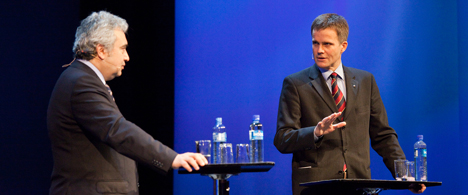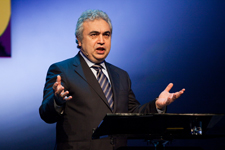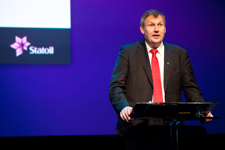
Helge Lund and Fatih Birol, chief economist at the International Energy Agency (IEA), at Statoil's autumn conference today. (Photo:Trond A Isaksen)
“I believe that industry players and governments share an agenda and have a common will to grip the climate and energy challenges facing the world,” said Lund.

IEA chief economist Dr Fatih Birol presented the IEA’s World Energy Outlook. (Photo: Trond A Isaksen)
The World Energy Outlook, published by The International Energy Agency (IEA), the energy markets and the climate challenge, were the main theme at Statoil’s autumn conference. Norway’s petroleum and energy minister Terje Riis-Johansen and IEA chief economist Dr Fatih Birol were among the keynote speakers.
“The world needs a step change towards a more sustainable energy future. As a long-term industry player we need a level playing field and predictable frame conditions,” said Lund.
“The negotiations in Copenhagen can outline the roadmap we need to mobilise the industry in its efforts to have more energy and less CO2.”
The chief executive stressed that the need for increased energy supplies for a developing world must be seen in connection with the climate challenge and the need for reduced CO2 emissions.
“As the IEA’s analyses show, fossil fuels will be critical for world energy supplies in the foreseeable future, regardless of scenario,” Lund noted.
“The world cannot choose today between fossil fuels and renewable energy – we need both. A wide range of initiatives is required; there is no silver bullet here.”
The chief executive maintained that Statoil is meeting the climate challenge on three fronts:
“First, we are seeking to ensure the lowest possible emissions from our operations. Let me remind you that carbon emissions per produced unit from the NCS are 60% below the world average.
“Second, we are actively pursuing carbon capture and storage (CCS). Three million tonnes of CO2 are captured annually from Algeria’s In Salah field and from the Sleipner and Snøhvit fields in Norway.
“The next generation of CCS technology is being developed at our Mongstad facility in partnership with the Norwegian government.
“In addition we are gradually building our commitment in the field of renewable energy. We have started out first major project in offshore wind power. Together with Statkraft we are investing more than NOK 10 billion in the Sheringham Shoal wind farm off the UK. This project will be able to supply 220,000 British homes with renewable energy,” said Lund.

Terje Riis-Johansen, Norway’s petroleum and energy minister, was one of the keynote speakers at the autumn conference. (Photo:Trond A Isaksen)
Terje Riis-Johansen said in his presentation that the Norwegian government has big expectations regarding the Copenhagen summit in December. He gave assurance that the Norwegian government wants to be a prime mover in efforts to meet the climate challenge and he said that the industrial nations are duty-bound to take the lead in this work.
Presenting the IEA’s World Energy Outlook Fatih Birol said that the financial crisis of the past year had led to reduced emissions and that the world now has a window of opportunity to stimulate industry and societies towards taking a more sustainable direction. He said that the world needs to cut heavily its consumption of coal and oil during the next 20 years to avoid serious consequences for the environment, adding that gas can play a key role in the transition to a cleaner energy future.